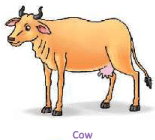Animals Around Us Class 1 Notes EVS
| Table of contents |

|
| Introduction |

|
| Can You Name the Animals? |

|
| Animals Come in Different Sizes |

|
| Types of Animals |

|
| Birds |

|
| Insects |

|
| Crossword Puzzle: Can You Guess the Animal? |

|
Introduction
- Look around, and you will see animals everywhere!
- Some animals live in our homes, some roam in the streets, and some stay in forests.
- Dogs, cats, cows, and squirrels are animals we see often.
- Birds fly in the sky, and fishes swim in the water.
- Some animals are big like elephants, while others are tiny like ants.
- Animals make our world lively and exciting!
- They help us in many ways—some give us milk, some carry heavy things, and some are our friends.
- Let’s learn more about the wonderful animals around us!

Can You Name the Animals?
Look at the pictures of animals and try to name them. Here’s a clue: the first letter of each animal’s name is given below!

- M__nk__y
- L__o__
- E__eph__n__
- Z__br__
- B__a__
- D__e__
- G__r__f__e
- S__ak__
Animals are of different sizes and shapes. Some are big while others are small.
Answers:
1. Monkey
2. Lion
3. Elephant
4. Zebra
5. Bear
6. Deer
7. Giraffe
8. Snake
Animals Come in Different Sizes
- Have you ever seen a big elephant or a tiny ant? Animals come in all sizes!
- Some animals are huge, like giraffes, whales, and elephants. They need lots of space and food.
- Some animals are tiny, like ants, butterflies, and mice. They can fit into small places and move quickly.
- Then there are animals that are just the right size, like dogs, cats, and rabbits—not too big, not too small!
- No matter their size, every animal is special! Let’s learn more about them!
1. Big Animals
- Some animals are very big! They are strong and need a lot of space to live.
- Elephants, giraffes, camels, and whales are some of the biggest animals.
- Elephants have big ears and long trunks, while giraffes have long necks to reach tall trees.
- Whales are the biggest animals in the world, but they live in the ocean!
- Big animals can help humans too—camels carry heavy things, and elephants are used for work in some places.
Some animals are large, like the Rhinoceros, Giraffe, Elephant, Horse, and Camel.

Fact: The largest living animal is the blue whale.
2. Small Animals
- Some animals are small, but they are fast, smart, and active! They live in forests, grasslands, and even near humans.
- Mice and rats run around quickly and can fit into tiny spaces to find food.
- Squirrels jump from tree to tree and store nuts to eat later.
- Wolves are smaller than lions and tigers, but they are strong and live in groups called packs.
- Monkeys are playful and clever—they can climb trees, swing on branches, and love to eat fruits.


3. Very Small Animals
- Some animals are even smaller and are often hard to spot!
- Ants are tiny but strong, carrying food much bigger than their own bodies.
- Earthworms live under the soil and help keep the soil soft and rich.
- Butterflies have colourful wings and flutter from flower to flower, making gardens beautiful.
- Cockroaches move quickly and hide in dark places, making them hard to catch!

Types of Animals
1. Domestic Animals
They are tamed by us because they are useful to us. They are kept by us around our homes.
Examples: Cow, Goat, Sheep, Horse etc.


2. Pet Animals
Those animals which we keep in our homes. We love them and play with them.
Examples: Dog, Cat, Parrot, Rabbit.
3. Wild Animals
Wild animals move freely in jungles. They are difficult to tame. They are seen in zoo or national parks.
Examples: Lions, Tigers, etc.

4. Farm Animals
Some useful animals like horses, camels, hens, cows and goats are kept on farms.
Uses:
- We get food from them.
- We get milk, eggs and meat from them.
- Some animals work for us. They carry heavy things, pull carts and dig the soil in our fields.
- We get wool from sheep.
- Honeybees collect honey for us.

5. Milch Animals
Animals that give us milk are called milch animals. Cow, goat and buffalo are milch animals.

Fun Fact: The fastest animal on land is Cheetah.
Birds
- Birds have two legs to walk and have wings and feathers to fly.
- They have beaks but no teeth.
- Note: Penguins, Kiwi and Ostrich cannot fly.

Insects
- They are very small animals.
- They have six legs.
- Some insects do not have wings like Ants and Spiders. All others have wings.

Crossword Puzzle: Can You Guess the Animal?
Now, let's play a fun game. Try to guess the animal based on the given hints below:

Solution:

|
33 videos|215 docs|44 tests
|
FAQs on Animals Around Us Class 1 Notes EVS
| 1. What are the main types of animals discussed in the article? |  |
| 2. How do animals vary in size according to the article? |  |
| 3. Why are birds and insects important to our environment? |  |
| 4. Can you name some examples of birds and insects mentioned in the article? |  |
| 5. How can we learn more about the animals around us? |  |


















